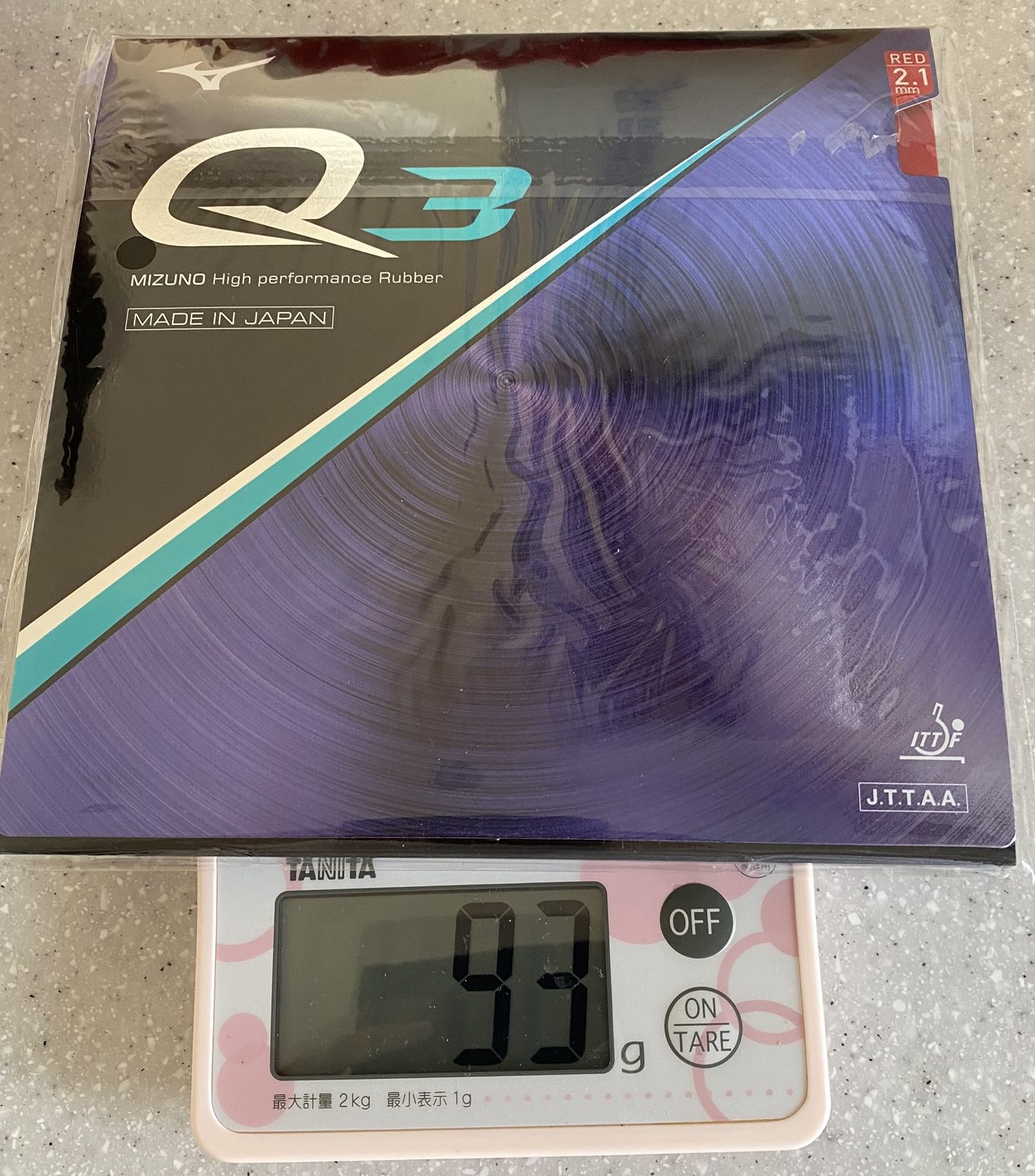
Explanation
MIZUNO, a major sports equipment brand, is a latecomer in the table tennis world, but in order to differentiate it from other table tennis manufacturers, we have taken on the challenge of co-developing rubber with Sumitomo Riko in the table tennis world. The jointly developed rubber is the Q series. The Q3 was released in 2017, and since its inception, it has been a hot topic as a challenging rubber jointly developed with Sumitomo Riko. Behind this is the fact that German-made rubber has emerged in the table tennis world in recent years, and the number of Japanese-made rubber is decreasing except for the Tenergy series and Dignics series of Butterfly. However, Mizuno searched for a manufacturer that could be jointly developed and developed rubber for top players from scratch. I think it was very challenging and had a stimulating effect on the table tennis world!
Speaking of Mizuno’s rubber before the Q series rubber, I think that the hit product of tension type front soft rubber, Booster series, tension type back soft rubber made in Germany, GF series can be mentioned. The booster series had a strong presence centered on female players, but the GF series did not penetrate much, to say the least. The price range was set to target the intermediate class rather than the top specifications. On the other hand, regarding the racket, Fortius FT, a 7-plywood racket supervised by former Japan national team player Ai Fujinuma, showed a certain presence due to its ease of handling and the power of the 7-plywood. However, once you buy a racket, it is not something that you will buy anew within a year, so it will be difficult to generate profits. Therefore, I think that the development of high-end tension-type back soft rubber that even top players can use has begun.
The rubber that seems to have been used as a reference in the joint development with Sumitomo Riko is probably the Monster Rubber, Tenergy series. Currently, there are three types of Q series sold, Q3, Q4, and Q5, but the Q3, which is reviewed on this page, is the rubber that is said to have the highest speed performance. It’s a rubber that corresponds to Tenergy 64 in the Tenergy series. The focus of this rubber is, after all, the sponges and sheets that are never used by rubber from other manufacturers. Although katsuo000 is not familiar with table tennis rubber manufacturing, basically each table tennis maker does not have a manufacturing factory, and specify the sheet material, sheet grain shape, sponge material, sponge hardness, etc. It seems that they are often outsourced. Therefore, there may be many combinations of sheet material, grain shape, sponge material, and sponge hardness, but the sheet material, grain shape, sponge material, and sponge hardness required for fashionable rubber are inevitably similar, so the same rubber. It will happen that the rubber manufactured in the manufacturing factory will inevitably look similar. However, the Q series is manufactured by Sumitomo Riko, and it seems that Sumitomo Riko does not manufacture other rubbers, so it is different from other table tennis equipment manufacturers. The manufacturer that does the same thing is Butterfly. You have your own factory, and you are trying to make a strong difference that rubber such as Tenergy and Dignix can only be made at the butterfly factory.
Various information is posted on Mizuno’s homepage, so I quoted it.
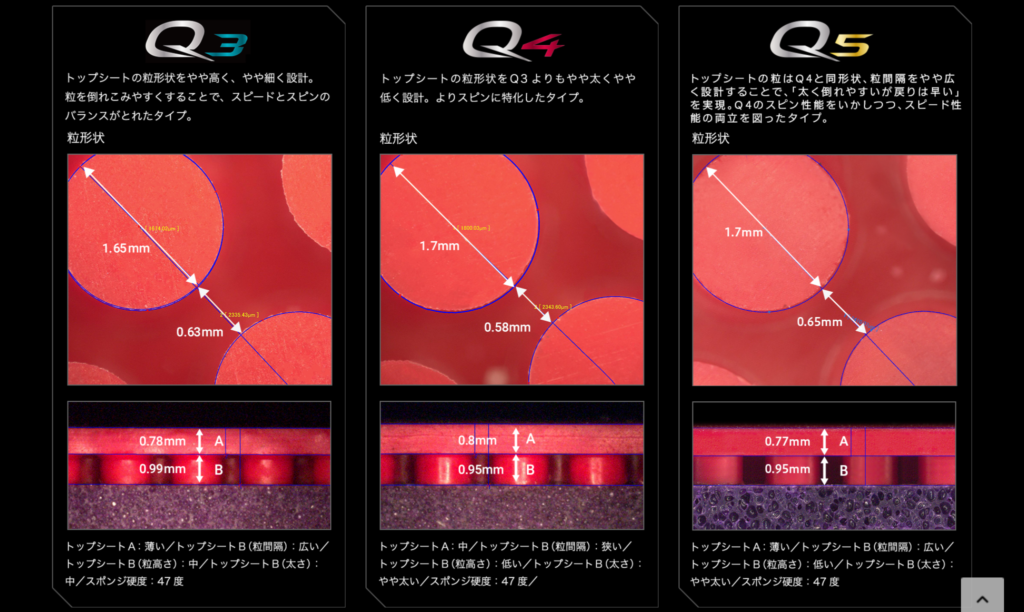
Q3 has a slightly thinner grain thickness of 1.65 mm and is adjusted to 0.63 mm between grains. The main axes of the Tenergy series, Tenergy 05, Tenergy 80, and Tenergy 64, have a grain thickness of 1.7 mm and the shortest distance between grains is Tenergy 05. , The middle is Tenergy 80, and the farthest is Tenergy 64. Q3 is a 1.65 mm grain that is thinner than 1.7 mm, and seems to be a rubber that is easy to fall down and speed up. In addition, the thickness of the sheet is 0.78 mm and the grain height is 0.99 mm, which is higher than other Q4 and Q5 grains, so you can imagine that it is a rubber that tends to show the characteristics of fine grains.
Published performance value
Published performance values exist in the GF series, but in the Q series, only figures and matrices exist. I quoted it from Mizuno’s homepage.

You can see that the Q series has higher speed and rotation performance than the GF series.

You can see that Q3 has a long flight distance. You can also see that the trajectory is the lowest.

The above figure is a fairly scientific figure, which is interesting for me personally, but difficult to understand. The rubber material used for rubber has viscoelasticity, so it is a diagram that quantifies how it responds to external forces.
This figure seems to be the efficiency of the force that tries to return when the force is applied to the rubber. It seems that if it is hard, the energy loss will increase. Imagine that you probably make a graph like this for each rubber composition. I think we are deriving a rubber that is reasonably hard and properly energy efficient.

It’s easy to understand. It can be said that Q3 has a grain shape equivalent to 64 in tenergy and dignics. However, you can also see that they are not exactly the same. Probably, the Q series seems to have been developed in combination with Mizuno’s signature racket, Fortius FT or Fortius FT ver. D (Fortius FT ver. D), and it seems to be a rubber that goes well with wood-based rackets. The wood racket has a good ball holding and is easy to rotate, but the speed is a little slow and the arch line is high and it is easy to come out. I think that it is a rubber specification that compensates for the slow speed and high arc line.
Q3 pasting and weight
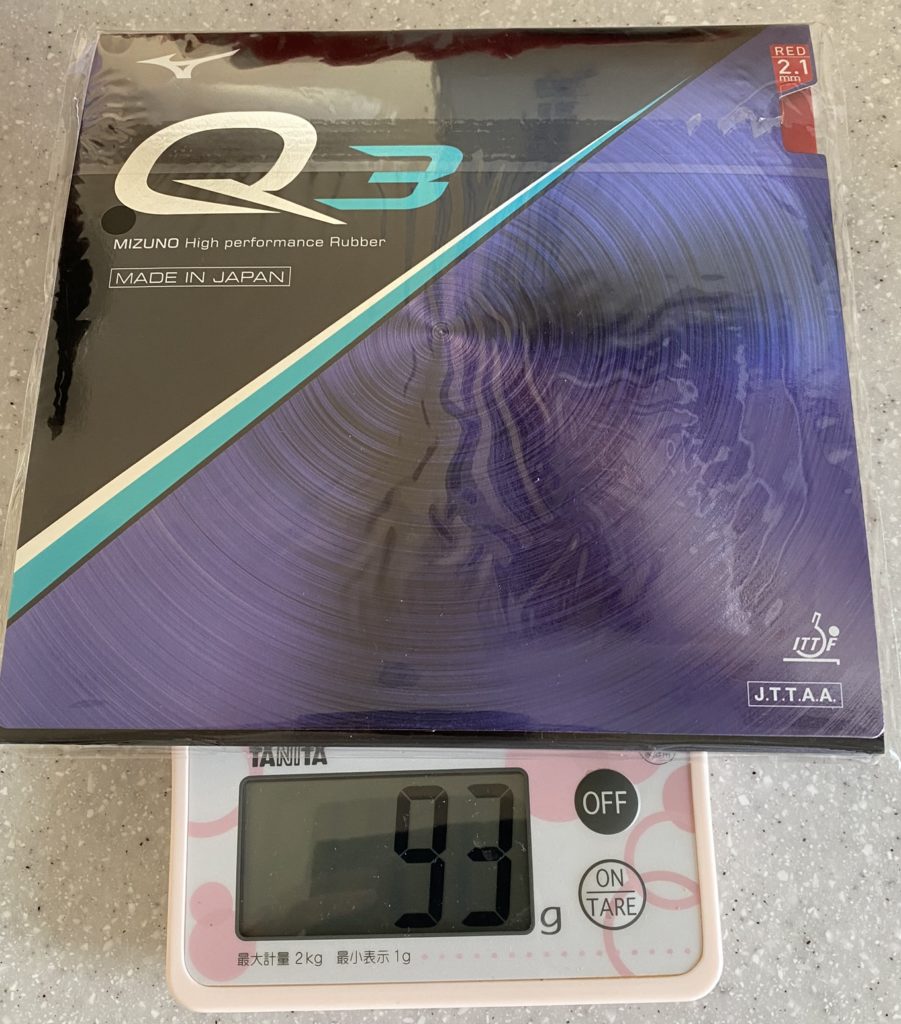
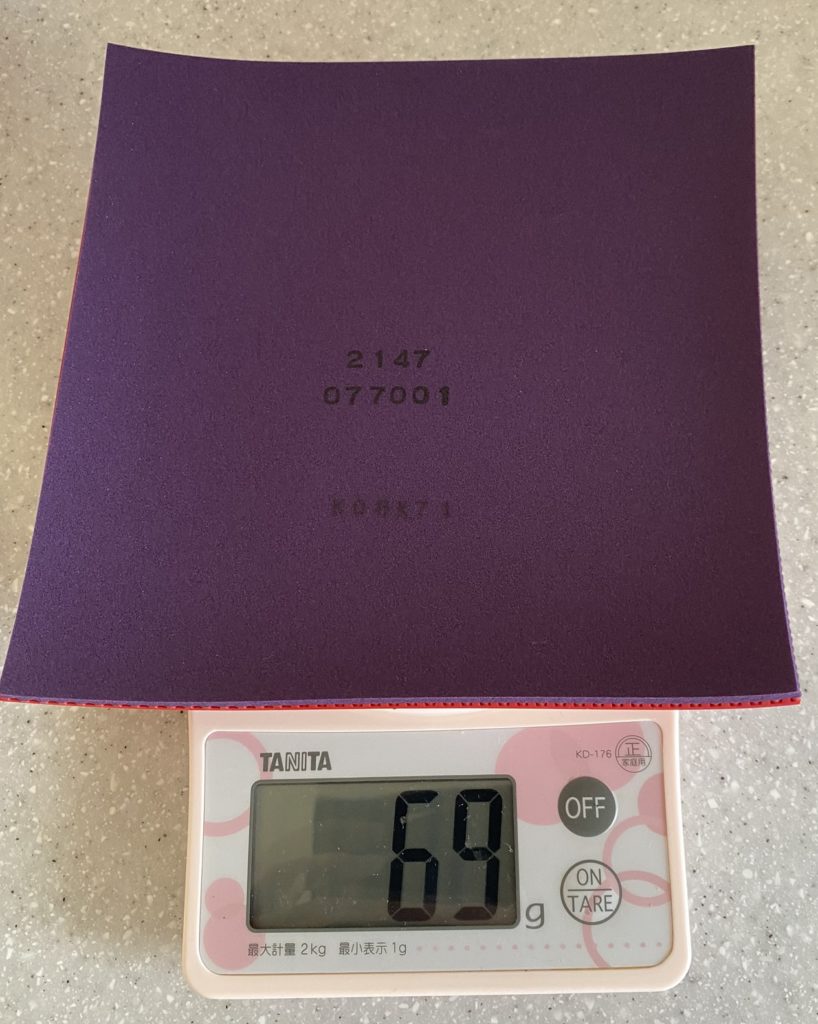
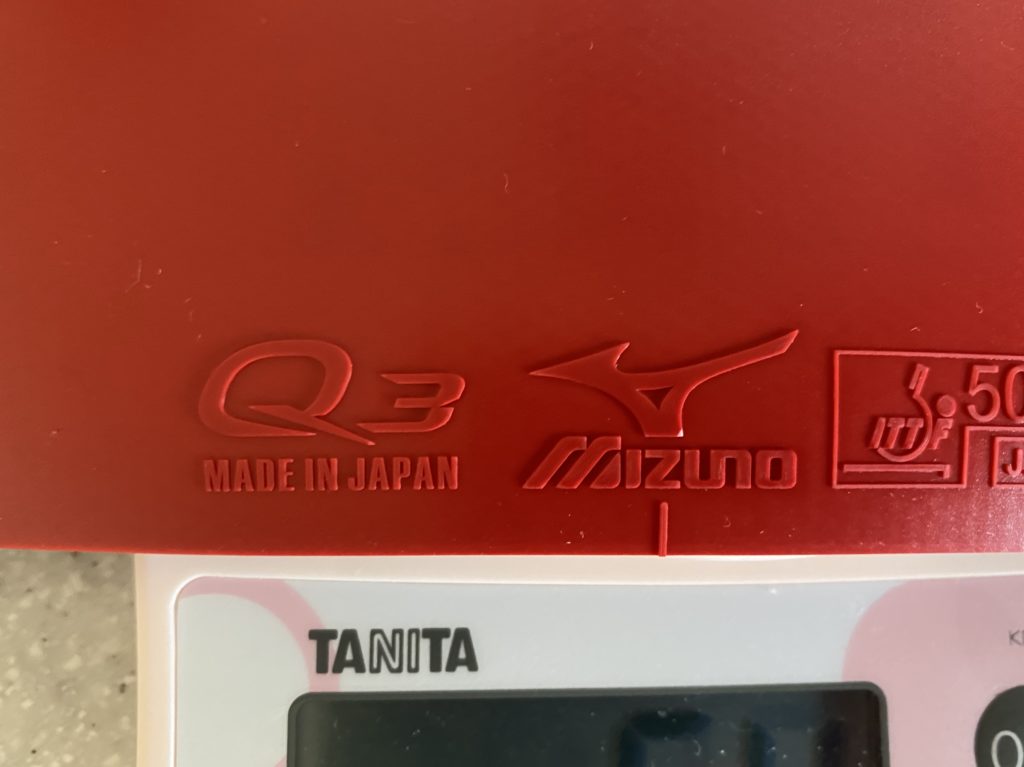
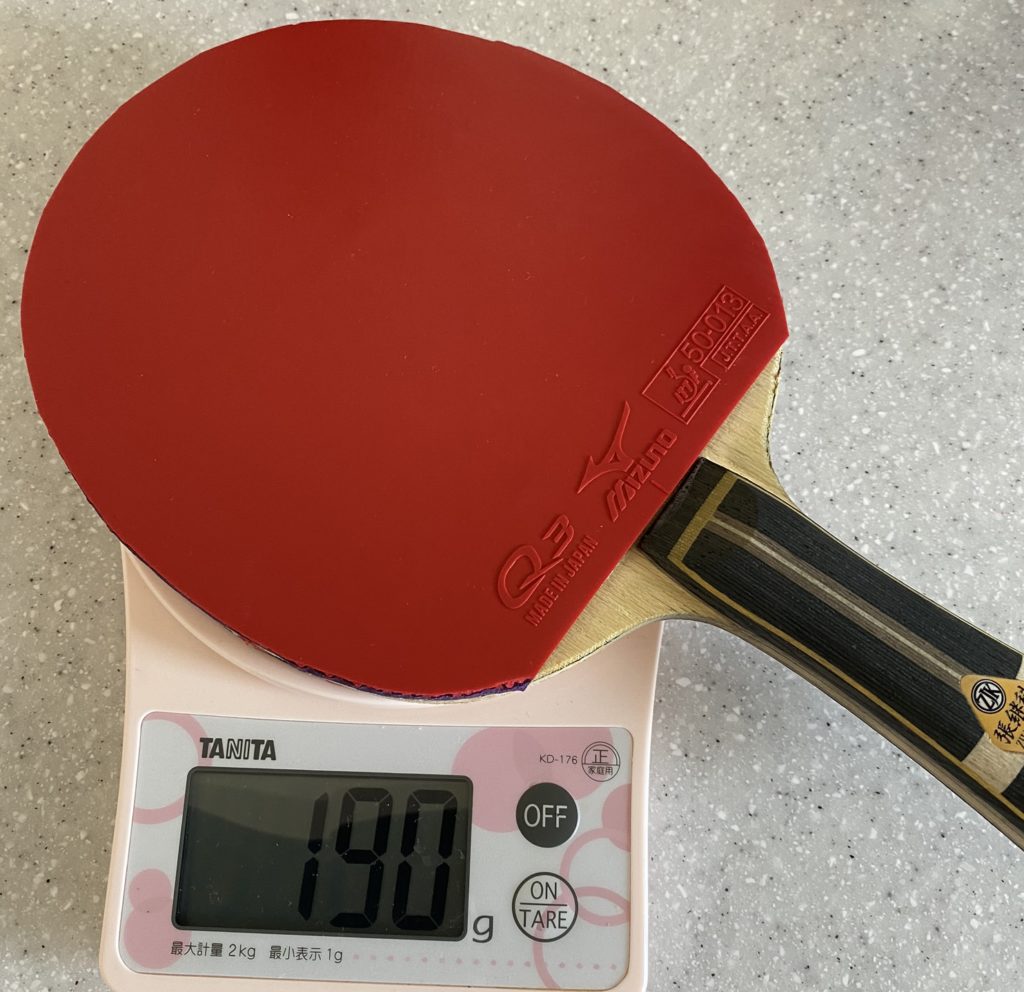
The warp of the rubber is amazing. I think it’s under tension. It is clearly warped compared to other manufacturers. By the way, sweat has a peculiar rubber odor.
Q3
Tension type XL52/3
Fine grain shape, narrow space between grains
・Sponge Thickness: middle (1.7 mm), thicke (1.9 mm), extra thick (2.1 mm)
・Sponge stiffness: 47
・6,300 yen + tax
・69 g (before cut) → 47 g (after cut)I felt it was light. Grain shape close to 64.
Three features of Q3
Hitting feeling like adhesive rubber!
Q3 was a spin-type tension rubber with a very matte shot feeling and just like an adhesive rubber! It feels like a sticky rubber, but the speed is more than enough for a spin-type tension rubber, and I felt that the amount of rotation and weight were at a minimum. Aside from the shot feeling, I felt that the ball I could hit was as good as the previous reputation. As an image, I felt that the sponge grain is a speed-type grain-shaped sheet that easily collapses, but the sponge is a fairly hard and hard rubber.
Push and stop were easy to short!
What surprised me was the Q3’s push and Stop, and it just stopped. The same was true for the other Q series, and it was difficult to float the push and Stop. I think it’s a great feature! It’s not easy to cut, but I was very impressed with how push and the stop stopped. When it became so easy to stop, I felt that I could use it as a normal job!
Easy to do counter drive!
In addition to push and Stop, the counter drive in Q3 was a very good feeling. Anyway, the overwriting type counter drive was a good impression, and there was a sense of versatility that you can usually enter by attracting and overwriting with the drive. I felt this was a very reliable rubber.
Each technics review
Forehand
Light hit
I feel the hardness. It was a feeling of hitting the ball because of its hardness.
Drive on long balls and rallies
It feels like the drive is about to fall due to its hardness. It is difficult to drive with a weak touch, and if you hit the drive, it will fall if you do not hit it. As I felt when I hit the drive, I felt that it would be better to combine it with a wood racket that makes it easy to draw a large arch line. It is exactly Fortius FT or Fortius FT ver. D. However, both are heavy rackets and have a large rubber area, so I think that it will be quite heavy if you attach the Q series.
The speed of the drive was quite good, and the arch line was drawn well. Compared to Rasanter R48, which has the same sponge hardness, it was clearly harder, mad and heavier.
Drive with open face
I expected it because it is a hard rubber, but I felt that it hit the board sooner than I expected. It may be because of Q3. I would like to expect from Q4 or Q5. There is a feeling of hitting the board, so if you let it bite too much, it will not rotate and it will be easy to make mistakes.
Loop (top spin) drive against back spin
Even in Q3, I got a fairly high quality loop drive. I felt that the amount of rotation would drop if I was a little lazy, but it was a loop drive that felt quite good even though it was a speed-type grain-shaped rubber. I would like to expect from Q4 and Q5.
Speed drive against back spin
This should be noted, and the speed drive was stable at about half the speed and half the rotation. It is unstable if it bites too much. I think it’s because it’s easy to hit the board.
Curve / shoot drive
I didn’t hit it very carefully, but it felt pretty good. It was better to get involved a little and drive a little like a curve drive, because the rotation is stronger and the ball is stable because of the lateral rotation.
Block
It was easy to do. I think this is because it is hard and not easily affected by the rotation of the other party.
Counter drive
I’m glad that the overwrite counter drive was easy to do. Also, I felt that the counter drive was easier to get speed than I expected and I didn’t intend to put it out, so it would be a drive that I could aim for no touch.
Stop
I’m glad it was easy to stop the ball. I think it is easier to stop than the hardness of the sponge.
Push
It was good that this was also low. However, it is not cut so much, so I think that good people can type it.
Serve
It was good to be able to cut it firmly. I felt that the minimum rotation was applied.
Backhand
Light hit
I didn’t feel that hard.
Drive on long balls and rallies
It was surprisingly easy to do, but when I was relaxed, I was late and flowed to the middle and fore. I think it’s a rubber that’s easy to drive.
Loop (top spin) drive against back spin
It was harder than I expected. The ball is released quickly, and if you try to hit it with just your hand, it will fall. I think that if you hit it firmly with your body, it will be stable enough.
Block
It was easy to do because it was hard and not affected by rotation very much. I think it’s difficult to take smashes.
Stop
It was easy to do. There was a net mistake because it stopped a little too much.
Push
It was good that this was also low. But it’s not cut.
Chiquita
It was easy to do. It goes up firmly.
Comparison with other rubbers (personal impressions)
Max spin amount
Dignics 05 > Q5 ≧ Tenergy 05 Hard > Q4 ≧Tenergy 05 > Q3 ≧ Tenergy 80
Speed
Dignics 05 > Tenergy 80 ≧ Q3 ≧ Q5 ≧ Q4 > Tenergy 05